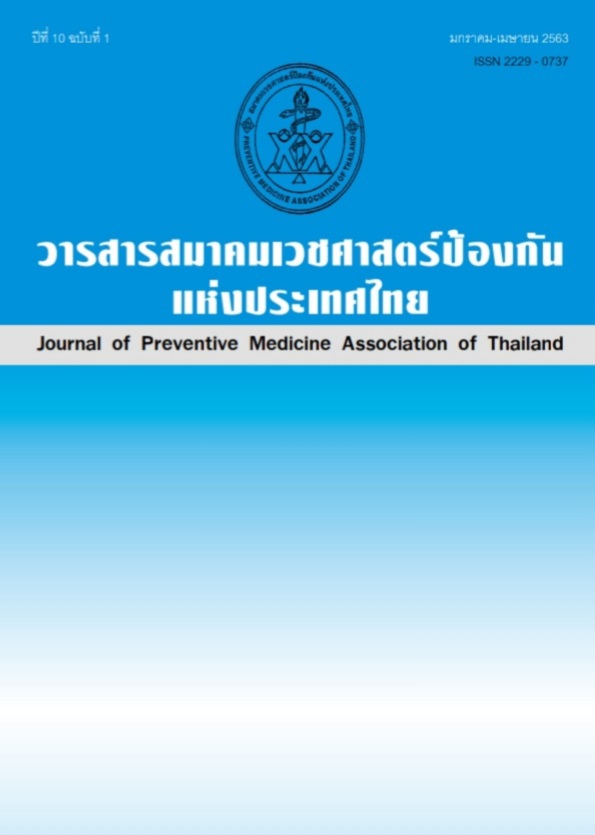The Development of a Care Model for Patients Receiving Warfarin Drug in Pakkred Hospital, Nonthaburi Province by Using Design Thinking as a Base
Keywords:
Model development, Multidisciplinary team, Design thinking as a base, Warfarin clinicAbstract
Objective : To develop a model of care for patients receiving warfarin in Pakkred Hospital, Nonthaburi Province using design thinking as a base by data from a-20 question test, the INR, thrombosis event, bleeding disorder, and patient and their relatives’ satisfaction. Methods and Materials : This study was a developmental research. The concept was designed by our 6-people multidisciplinary team from 1st January-31st July 2019. At the same time period, we enrolled 60 voluntary participants receiving warfarin with the percentage of INR within the target less than or equal to 50% or experiencing adverse drug reactions. Thereafter, we implied the concept to them from 1st August- 31st December 2019. The research was divided into 4 phases 1) learning situation 2) model development 3) model testing 4) model evaluation. The tools used in the research consists of 1) the format and guidelines of care for patients receiving warfarin which designed and developed by the researcher 2) the three data collection forms (patient data, test their knowledge and the INR) 3) Evaluation forms of the patients and their relatives’ satisfaction. Results : Average score on knowledge regarding drug use increased from 15.932.583 to 19.83
0.526 (P< 0.001), while the percentage of time of the INR in target range of treatment increased from 40.68% to 52.15%. Percentage of bleeding disorders decreased from 2.26% to 0.61%. Interestingly, patients and relatives were satisfied with the highest level at 89.45%. Comment and Suggestion : These results showed that the development model improved indicators significantly and the innovative model could be used to improve patient care in the future.
References
2. สมาคมแพทย์์โรคหัวใจแห่งประเทศไทย ในพระบรมราชูปถัมภ์. แนวทางการรักษาผู้ป่วยด้วยยาต้านการแข็งตัวของเลือดชนิดรับประทาน. ม.ป.ท.; 2555.
3. นุชจรี กิจวรรณ. กระบวนการคิดเชิงออกแบบ : มุมมองใหม่ของระบบสุขภาพไทย. วารสารสภาการพยาบาล 2561;33:5-14.
4. Coleman K, Austin BT, Brach C, Wagner EH. Evidence on the chronic Care Model in the new millennium. Heath Aff (Millwood) 2009;28:75-85.
5. Kimmel SE, French B, Kasner SE, Johnson JA, Anderson JL, Gage BF, et al. A pharmacogenetic versus a clinical algorithm for warfarin dosing. N Engl J Med [Internet]. 2013 [cited 2019 Oct 22];369:2283-93. Available from: https://www.ncbi.
nlm.nih.gov/pubmed/24251361
6. Chiquett E, Amato MG, Bussey HI. Comparison of an anticoagulant clinic with usual medical Care: anticoagulation control, patient outcomes, and health care costs. Arch Intern Med 1998;158:1641-7.
7. นาตยา หวังนิรัติศัย, สกนธ์ สุภากุล, ภูขวัญ อรุณมานะกุล. ผลของการบริบาลทางเภสัชกรรมในผู้ป่วยที่ได้รับยาวาร์ฟารินของคลินิกวาร์ฟาริน โรงพยาบาลสวรรค์ประชารักษ์. วารสารเภสัชกรรมไทย 2561;10:120-8
8. Kamput V, Nakariyakul K. Clinical outcomes of warfarin monitoring in outpatients at Buddhachinaraj Phitsanulok hospital. Buddhachinaraj Medical Journal 2009;26:253-9.
9. เกสร สังข์กฤษ, ทัศนีย์ แดขุนทด. การพัฒนารูปแบบการดูแลผู้ป่วยที่ได้รับยาวาร์ฟาริน โรงพยาบาลสกลนคร. วารสารสมาคมพยาบาลฯ สาขาภาคตะวันออกเฉียงเหนือ 2555;30:96-108.
Downloads
Published
How to Cite
Issue
Section
License
บทความที่ลงพิมพ์ในวารสารเวชศาสตร์ป้องกันแห่งประเทศไทย ถือเป็นผลงานวิชาการ งานวิจัย วิเคราะห์ วิจารณ์ เป็นความเห็นส่วนตัวของผู้นิพนธ์ กองบรรณาธิการไม่จำเป็นต้องเห็นด้วยเสมอไปและผู้นิพนธ์จะต้องรับผิดชอบต่อบทความของตนเอง






